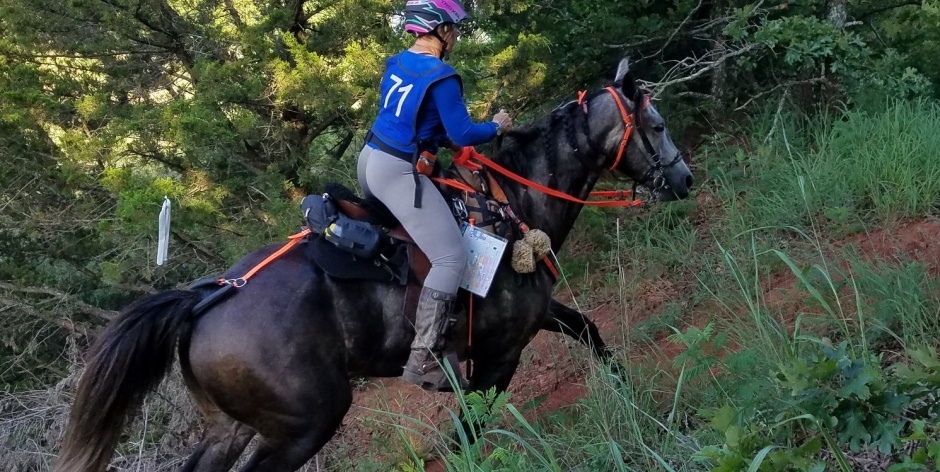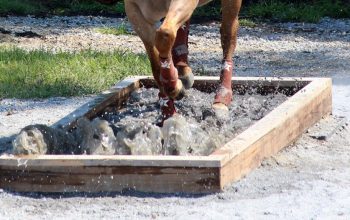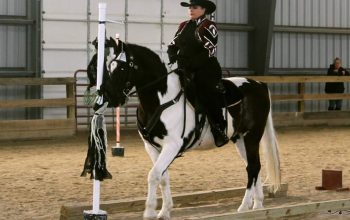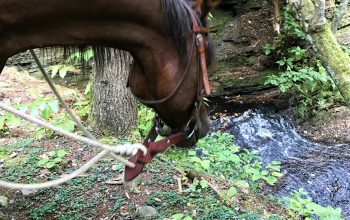by Tammy Vasa, NATRC
Recently on Facebook, I quickly tried to debunk some of the myths and concerns associated with competitive trail riding (CTR). Am I an expert? No. But I was once the person who had these same fears. My desire to try the sport finally prevailed as most of the worries were a non-issue. As a casual competitor with just under eight hundred competition miles, I have been involved with the sport for over a decade and heading into my fourth year as a ride manager.
Here are the Top 10 reasons I was concerned about competing and what I learned from the sport which debunked those fears.
1. My horse will NEVER do THAT (fill in the blank)!

From lunging, picking up her feet to standing at mounting — even at 15 years old, my mare still has a mind of her own. Or perhaps she still has my number (most likely). She has never been an easy horse, or perhaps I have never been the best rider. However, when I look at where we started — kicking out at the touch of a stethoscope to almost running a judge off the trail – she managed to pull off a few wins and enough points to garner the 2015 Region 6 Novice Champion.
She didn’t do it on her own; we did it as a team with me as her leader. We practiced at home. We practiced while pleasure riding. Some of it was probably subconsciously planted by the sport and we improved. All horses are smart, and as owners we need to find the way to communicate better with our equine partner. Through competition I learned how much we lacked in this department, and because of the sport itself, I became a better competitor.
2. OMG I have to tie my horse to the trailer overnight! She will die! She needs to rest and lie down and stretch her legs and exercise and roll! I will not risk my horse’s health or my beautiful trailer having her tied up overnight!
If tied correctly, the horse is as safe as it would be in a stall or corral, and trust me, the horse doesn’t want to exercise any more than you will following a ride. Coming back to the trailer at the end of the ride is the horse’s happy place, and tied correctly, your horse can lie down if she chooses. Sure, you might feel movement on the trailer at night, but it’s not like she is tap dancing on the side of the trailer. If the horse does get in trouble, you will be the first to hear or feel it, unlike being cast in an unfamiliar corral or pen.

Have you ever seen all the rodeo horses standing tied to an arena? Our horses are competition horses, and like those rodeo horses, they know it is their resting place. You will be surprised. In addition, you never have to worry about where to stable your horse in an emergency because they can stand safely at your trailer.
3. Obstacles. You want me to do WHAT (fill in the blank)?
I could get myself into quite a tizzy worrying about obstacles. When riding with my husband, I couldn’t figure out if he should go first or if I should go first; my heart would pound. However, if you look closely at your horse’s score card, it is more important to be healthy and sound than it is to back between two trees. My horse can sometimes ace the metabolic checks and soundness. She might not sidepass pretty over a log, but has won because she is fit and healthy.

I went from fear of obstacles to looking forward to them and being a bit disappointed if we don’t see the judge as often as I hoped! The horsemanship card helps me to be a better rider. We can’t look in the mirror when riding down the trail, but we can be seen in an expert’s eyes and be provided with useful feedback.
4. I could never ride that far and that fast!

Novice competitors ride about 15 to 20 miles each day. The speed varies over terrain but most generally not more than 4 mph. A good trail horse can easily walk a 4 mph pace if asked. When I ride with my pleasure riding friends, we usually average around 2.5 mph (yawn), and my legs and back are feeling it by the end of the ride. I enjoy changing gaits to keep my body in motion. I mix up my pace with walking and trotting and maybe even lope if I find the perfect spot. Most riders will keep it at a walk and occasional trot. Time goes very fast on the trail, and you will be surprised when the ride is over.
5. The entry fees are too pricy.
Unless you are riding at home, anytime you haul a horse off the property, there are expenses. When riding CTR, you will incur camping fees, health papers charges and ride fees. Not to mention fuel and necessities while camping. If you were going to a barrel race or roping, you would most likely incur those same fees, and your ride would only last a few seconds. You might get a few minutes in the arena at a horse show and pay an entry for each class. Our sport keeps you on your horse for 2 days and is money well spent.
You can’t put a price tag on the judges. The horses are judged by a licensed veterinarian. It will receive a thorough soundness exam at check in. The vet will check for hydration levels, gut sounds and other metabolic conditions and will do it all over again at check out. During competition they will continue to check soundness and condition on the trail when the horse is working and will check for soreness following the ride. The pulse & respiration crew will record the horse’s vitals twice during each day. You will learn how to get your horse to relax, to get into the zone for a good recovery. Your horse is under the eye of a vet from the time it checks in until it checks out. Your entry fee is cheap when you consider the rewards.

The horsemanship judge will judge you on your equitation, in-hand presentation, grooming, stabling, safety and courtesy, and your tack and equipment. That doesn’t mean they are going to tell you to buy a new saddle, but they may note if your breast collar is too tight or your latigo so cracked and worn that it might be a safety issue. They might offer suggestions for saddle adjustments to alleviate possible pain or galling on your horse, and you might lose a point for being heavy in the saddle or hindering your horse’s movement. While his or her job is to distinguish your horsemanship from that of another rider, you should also look at it as having a personal trainer helping you to become a better equestrian.
All this training and education is included in the cost of the ride. You will go home with your scorecard serving as your “homework” – a part of making you more successful as a rider in general as well as in this sport.
6. Snobs! All the riders are prima donnas!

“Do not judge a person too harshly as you don’t know what battle they may be fighting.” Perhaps a little melodramatic but you know what I mean. Maybe the person who snubbed you just found out their horse is lame. Or perhaps they are in competition for a national award and plotting their ride or most likely just in their own zone. Don’t let the actions of one or two be indicative of our sport. Ride managers like to pair new riders with a mentor, and many of our seasoned riders love mentoring. And don’t be shy! Ask questions! We are here to help. If you get your feelings hurt, brush it off and move on. Look for the positive. This is not the sport for the passive aggressive! There is a camaraderie among riders that is second to none. You will get to know the riders not only from your region but others regions as well. The first ride is the toughest. Take that first step.
7. All I have is a western saddle!
I started out in my western saddle, a horn bag, a hoof pic, a wind-up watch, a knife, a granola bar or an apple, a rain slicker and a couple bottles of water. I pretty much ride the same way today, sans the horn on my saddle and added a GPS. My husband still competes with his western saddle with a horn and a rear cinch and a cowboy hat. You will see English saddles, endurance saddles and treeless saddles. It doesn’t matter as long as it fits you and fits your horse. You will also find riders trading gear all the time! I don’t think I have bought a new piece of tack in a long time but have traded and bought and sold online.

8. I can’t ride for 2 days.
Easy. Pick a ride that has a B-Ride which is a 1-day competition. It will give you the feel for the competition and expectations, and I bet before long, you will pull a 2 day-er!
9. I don’t ride an Arabian!
Neither do I! I ride a Quarter Horse. We have successfully ribboned out of the Novice Division and have competed in the Open Division at a couple of rides. We may land in Competitive Pleasure this coming year, but I am pleased that with the right conditioning, my horse can compete in all divisions of this sport. You will see Arabians on the trail. You will also see Missouri Fox Trotters and Mustangs and Appaloosas. Just this last weekend, the first place novice horse was a draft. It’s a sport for any horse or mule; they can all be athletes.
10. I will never have the fastest horse in the competition. I am not even competitive!
Competitive trail riding is NOT a race. It is NOT an endurance ride. It IS a timed event. Riding at pace, you have a 30 minute window to complete the ride. It does not matter if you are first in that window or last in the window – your scorecard will not reflect your order across the finish line – only that you completed it in the time given. And if you are late, it will cost you some points, but you will still be in the game. And while getting from Point A to Point B, you will see some beautiful trail along the way.
By the same token, competitive trail riding is not just a trail ride. It is a competition – a sport – that established rules and guidelines 57 years ago. Like any sport, tweaks are made along the way, but the foundation of this sport has passed the test of time. The expectations of a good trail horse exist today the same as they did in 1960.
You may not think you are a competitive person but in our sport, you will start competing against previous scorecards just to see yourself improve. If you bring in a placing as a result, that is gravy!
If you want to go on a trail ride – great. Grab some friends and hit the trail. If you want to bump it up a notch, consider our competitive trail riding. It is exhilarating and the lessons you will learn are priceless.
This article originally appeared in the April issue of Sport and Trail Magazine





